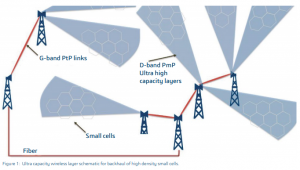Claudio Paoloni, Head of Engineering Department and Cockcroft Chair, Lancaster University authored the blog post below. This article was originally published in the June 2018 issue of SIMULIA Community News magazine.
The huge increase of internet traffic wireless, fostered by video streaming, high-resolution cameras and the large number of connected portable devices—in addition to the need of operators assuring the best customer experience—has no other solution than the deployment of high density small cell networks, to serve less users for base station. The challenge is to provide cost effective backhaul to a high number of cells distributed in urban areas.
Fiber, due to the cost and difficult deployment, can only partially solve the problem. Wireless backhaul is, in principle, an attractive solution of easy installation and high flexibility. However, to support the increasing demand of multi-gigabit capacity, only the wide frequency bands available at millimeter waves (90–320 GHz) are suitable for the purpose. The high atmosphere attenuation and the low transmission power from solid-state devices have so far prevented the exploitation of the millimeter wave spectrum that needs a step change in technology.
Two European Commission Horizon 2020 projects, TWEETHER “Travelling wave tube based w-band wireless networks with high data rate distribution, spectrum & energy efficiency” and ULTRAWAVE “Ultra capacity wireless layer beyond 100 GHz based on millimeter wave Traveling Wave Tubes”, respond to the quest of high capacity and high density cell backhaul to support future 5G networks by proposing, for the first time, the exploitation of the whole millimeter wave spectrum beyond 90 GHz.
The H2020 TWEETHER project is the first project to enable Point-to-multi-Point distribution above 90 GHz, by using a novel W-band Traveling Wave Tube (TWT) to provide millimeter wave transmission power at Watt level, to overcome the high atmosphere attenuation. Point-to-mult-Point permits to feed with a single transmission hub, with low footprint, a high number of terminals or base stations, distributed on a wide area. The 3-GHz bandwidth available in the range 92–95 GHz provides up to 10 Gb/s per kilometer square. The technology developed in the TWEETHER project will open the exploitation of the W-band with a new backhaul paradigm and will help to solve the digital divide by fixed access distribution in residential and suburban areas usually not covered by fiber.

The “beyond 5G” ULTRAWAVE project aspires to create an ultra capacity layer providing up to 100 Gb/s per kilometer square in Point-to-multi-Point at D-band (141–174.8 GHz) by a deployment of transmission hubs to cover sectors with up to 500 m radius. The transmission hubs are backhauled by novel G-band (275–305 GHz) Point-to-Point high-capacity links, with an unprecedented 30 Gb/s data rate, over up to 500 m range (Figure 1). The system is empowered by the convergence of three main technologies: vacuum electronics, solid-state electronics and photonics in a unique wireless system. The needed transmission power, at Watt level, is generated by novel D-band and G-band Traveling Wave Tubes (Figure 2).

These novel millimeter wave wireless systems pose relevant design challenges due to limited experimental background, unconventional three-dimensional structures with sub millimeter dimensions and high development cost. In particular, millimeter wave TWTs are still at laboratory level and no consolidated procedures exist for their design and fabrication. A TWT consists of a waveguide of defined shape that slows down the propagating wave velocity to synchronize it with an electron beam flowing in the slow wave structures in order to transfer energy from the beam to the wave. The mechanism, in principle simple, when translated in the simulation domain, requires a substantial computational effort due to millions of particles associated to the electrons of the beam flowing in a complex geometrical structure, modelled by a high density mesh.
The availability of accurate and flexible three dimensional electromagnetic simulators, as CST Studio Suite, is pivotal for the design and simulation of slow wave structures with dimensions of the parts in the hundreds of micron range and arbitrary shapes. The characterization of the electrical behavior of slow wave structures, including parameters related to materials and fabrication processes, is then followed from the more demanding prediction of the nonlinear performance, derived by the interaction of the electromagnetic field with the electron beam. The complex physic phenomena and the high number of particles needed to model an electron beam and the large 3D computational field requires accurate and efficient models and algorithms. The TWT design team mainly uses CST Studio Suite, which permits extensive and fast simulations due to the optimized algorithm and the support of the most advanced GPUs, with a substantial reduction of the simulation time in comparison to similar CAD tool. Figure 3 shows the electron beam behavior while flowing along the interaction structure.
The fabrication and measurement of the millimeter wave and THz TWTs, will be a substantial step to calibrate 3D simulators on real devices.

Claudio Paoloni received the degree in Electronic Engineering from a University of Rome “Sapienza”, Rome, Italy, in 1984. Since 2012, he has been a Professor of Electronics with the Department of Engineering, Lancaster University, Lancaster, UK Since 2015, he has been the Head of the Engineering Department. He is the author of more that 200 publications. He is coordinator of the Horizon 2020 projects, TWEETHER and ULTRAWAVE for millimetre waves high capacity wireless networks. His research fields are millimetre wave vacuum electronics devices and applications. He is an IEEE Senior Member. He is Chair of the IEEE Electron Device Society Vacuum Electronics Technical Committee.
Lancaster University is one of the UK’s top universities, recently named the University of the Year by The Times and The Sunday Times Good University Guide 2018. The Engineering Department at Lancaster University is a General Engineering Department of recognised excellence in research and teaching, with a clear growth strategy. Engineering research there was rated as world leading in the 2014 Research Excellence Framework (REF), being placed 7th in the UK in the Times Higher Research Intensity league table.
For More Information: www.lancaster.ac.uk/engineering
